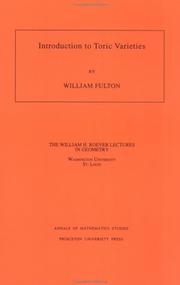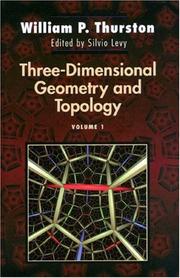| Listing 1 - 2 of 2 |
Sort by
|

ISBN: 0691000492 0691033323 1400882524 Year: 1993 Publisher: Princeton Princeton university press
Abstract | Keywords | Export | Availability | Bookmark
 Loading...
Loading...Choose an application
- Reference Manager
- EndNote
- RefWorks (Direct export to RefWorks)
Toric varieties are algebraic varieties arising from elementary geometric and combinatorial objects such as convex polytopes in Euclidean space with vertices on lattice points. Since many algebraic geometry notions such as singularities, birational maps, cycles, homology, intersection theory, and Riemann-Roch translate into simple facts about polytopes, toric varieties provide a marvelous source of examples in algebraic geometry. In the other direction, general facts from algebraic geometry have implications for such polytopes, such as to the problem of the number of lattice points they contain. In spite of the fact that toric varieties are very special in the spectrum of all algebraic varieties, they provide a remarkably useful testing ground for general theories. The aim of this mini-course is to develop the foundations of the study of toric varieties, with examples, and describe some of these relations and applications. The text concludes with Stanley's theorem characterizing the numbers of simplicies in each dimension in a convex simplicial polytope. Although some general theorems are "ed without proof, the concrete interpretations via simplicial geometry should make the text accessible to beginners in algebraic geometry.
Algebraic geometry --- Differential geometry. Global analysis --- 512.7 --- Algebraic geometry. Commutative rings and algebras --- Toric varieties. --- 512.7 Algebraic geometry. Commutative rings and algebras --- Toric varieties --- Embeddings, Torus --- Torus embeddings --- Varieties, Toric --- Algebraic varieties --- Addition. --- Affine plane. --- Affine space. --- Affine variety. --- Alexander Grothendieck. --- Alexander duality. --- Algebraic curve. --- Algebraic group. --- Atiyah–Singer index theorem. --- Automorphism. --- Betti number. --- Big O notation. --- Characteristic class. --- Chern class. --- Chow group. --- Codimension. --- Cohomology. --- Combinatorics. --- Commutative property. --- Complete intersection. --- Convex polytope. --- Convex set. --- Coprime integers. --- Cotangent space. --- Dedekind sum. --- Dimension (vector space). --- Dimension. --- Direct proof. --- Discrete valuation ring. --- Discrete valuation. --- Disjoint union. --- Divisor (algebraic geometry). --- Divisor. --- Dual basis. --- Dual space. --- Equation. --- Equivalence class. --- Equivariant K-theory. --- Euler characteristic. --- Exact sequence. --- Explicit formula. --- Facet (geometry). --- Fundamental group. --- Graded ring. --- Grassmannian. --- H-vector. --- Hirzebruch surface. --- Hodge theory. --- Homogeneous coordinates. --- Homomorphism. --- Hypersurface. --- Intersection theory. --- Invertible matrix. --- Invertible sheaf. --- Isoperimetric inequality. --- Lattice (group). --- Leray spectral sequence. --- Limit point. --- Line bundle. --- Line segment. --- Linear subspace. --- Local ring. --- Mathematical induction. --- Mixed volume. --- Moduli space. --- Moment map. --- Monotonic function. --- Natural number. --- Newton polygon. --- Open set. --- Picard group. --- Pick's theorem. --- Polytope. --- Projective space. --- Quadric. --- Quotient space (topology). --- Regular sequence. --- Relative interior. --- Resolution of singularities. --- Restriction (mathematics). --- Resultant. --- Riemann–Roch theorem. --- Serre duality. --- Sign (mathematics). --- Simplex. --- Simplicial complex. --- Simultaneous equations. --- Spectral sequence. --- Subgroup. --- Subset. --- Summation. --- Surjective function. --- Tangent bundle. --- Theorem. --- Topology. --- Toric variety. --- Unit disk. --- Vector space. --- Weil conjecture. --- Zariski topology.

ISBN: 0691083045 1400865328 9780691083049 Year: 1997 Volume: 35. Publisher: Princeton : Princeton University Press,
Abstract | Keywords | Export | Availability | Bookmark
 Loading...
Loading...Choose an application
- Reference Manager
- EndNote
- RefWorks (Direct export to RefWorks)
This book develops some of the extraordinary richness, beauty, and power of geometry in two and three dimensions, and the strong connection of geometry with topology. Hyperbolic geometry is the star. A strong effort has been made to convey not just denatured formal reasoning (definitions, theorems, and proofs), but a living feeling for the subject. There are many figures, examples, and exercises of varying difficulty. This book was the origin of a grand scheme developed by Thurston that is now coming to fruition. In the 1920s and 1930s the mathematics of two-dimensional spaces was formalized. It was Thurston's goal to do the same for three-dimensional spaces. To do this, he had to establish the strong connection of geometry to topology--the study of qualitative questions about geometrical structures. The author created a new set of concepts, and the expression "Thurston-type geometry" has become a commonplace. Three-Dimensional Geometry and Topology had its origins in the form of notes for a graduate course the author taught at Princeton University between 1978 and 1980. Thurston shared his notes, duplicating and sending them to whoever requested them. Eventually, the mailing list grew to more than one thousand names. The book is the culmination of two decades of research and has become the most important and influential text in the field. Its content also provided the methods needed to solve one of mathematics' oldest unsolved problems--the Poincaré Conjecture. In 2005 Thurston won the first AMS Book Prize, for Three-dimensional Geometry and Topology. The prize recognizes an outstanding research book that makes a seminal contribution to the research literature. Thurston received the Fields Medal, the mathematical equivalent of the Nobel Prize, in 1982 for the depth and originality of his contributions to mathematics. In 1979 he was awarded the Alan T. Waterman Award, which recognizes an outstanding young researcher in any field of science or engineering supported by the National Science Foundation.
Topology --- Differential geometry. Global analysis --- Geometry, Hyperbolic --- Three-manifolds (Topology) --- Géométrie hyperbolique --- Variétés topologiques à 3 dimensions --- Geometry, Hyperbolic. --- 514.1 --- 3-manifolds (Topology) --- Manifolds, Three dimensional (Topology) --- Three-dimensional manifolds (Topology) --- Low-dimensional topology --- Topological manifolds --- Hyperbolic geometry --- Lobachevski geometry --- Lobatschevski geometry --- Geometry, Non-Euclidean --- General geometry --- Three-manifolds (Topology). --- 514.1 General geometry --- Géométrie hyperbolique --- Variétés topologiques à 3 dimensions --- 3-sphere. --- Abelian group. --- Affine space. --- Affine transformation. --- Atlas (topology). --- Automorphism. --- Basis (linear algebra). --- Bounded set (topological vector space). --- Brouwer fixed-point theorem. --- Cartesian coordinate system. --- Characterization (mathematics). --- Compactification (mathematics). --- Conformal map. --- Contact geometry. --- Curvature. --- Cut locus (Riemannian manifold). --- Diagram (category theory). --- Diffeomorphism. --- Differentiable manifold. --- Dimension (vector space). --- Dimension. --- Disk (mathematics). --- Divisor (algebraic geometry). --- Dodecahedron. --- Eigenvalues and eigenvectors. --- Embedding. --- Euclidean space. --- Euler number. --- Exterior (topology). --- Facet (geometry). --- Fiber bundle. --- Foliation. --- Fundamental group. --- Gaussian curvature. --- Geometry. --- Group homomorphism. --- Half-space (geometry). --- Holonomy. --- Homeomorphism. --- Homotopy. --- Horocycle. --- Hyperbolic geometry. --- Hyperbolic manifold. --- Hyperbolic space. --- Hyperboloid model. --- Interior (topology). --- Intersection (set theory). --- Isometry group. --- Isometry. --- Jordan curve theorem. --- Lefschetz fixed-point theorem. --- Lie algebra. --- Lie group. --- Line (geometry). --- Linear map. --- Linearization. --- Manifold. --- Mathematical induction. --- Metric space. --- Moduli space. --- Möbius transformation. --- Norm (mathematics). --- Pair of pants (mathematics). --- Piecewise linear manifold. --- Piecewise linear. --- Poincaré disk model. --- Polyhedron. --- Projection (linear algebra). --- Projection (mathematics). --- Pseudogroup. --- Pullback (category theory). --- Quasi-isometry. --- Quotient space (topology). --- Riemann mapping theorem. --- Riemann surface. --- Riemannian manifold. --- Sheaf (mathematics). --- Sign (mathematics). --- Simplicial complex. --- Simply connected space. --- Special linear group. --- Stokes' theorem. --- Subgroup. --- Subset. --- Tangent space. --- Tangent vector. --- Tetrahedron. --- Theorem. --- Three-dimensional space (mathematics). --- Topological group. --- Topological manifold. --- Topological space. --- Topology. --- Transversal (geometry). --- Two-dimensional space. --- Uniformization theorem. --- Unit sphere. --- Variable (mathematics). --- Vector bundle. --- Vector field. --- Topologie algébrique --- Topologie combinatoire --- Algebraic topology. --- Combinatorial topology. --- Variétés topologiques --- Geometrie --- Theorie des noeuds
| Listing 1 - 2 of 2 |
Sort by
|

 Search
Search Feedback
Feedback About
About Help
Help News
News